Ancient Indian Agriculture:-tools and technology
Ancient Indian Agriculture
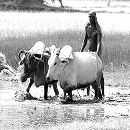 ManuringThe excavation of the Mehrgarh period sites that is around 8000-6000 BC throws some startling facts about Indian agriculture that began as early as 9000 BC. The domestication of plants and animals are reported in the subcontinent by 9000 BC. Wheat, barley and jujube were among crops, sheep and goats were among animals that were domesticated. This period also saw the first domestication of the elephants.
ManuringThe excavation of the Mehrgarh period sites that is around 8000-6000 BC throws some startling facts about Indian agriculture that began as early as 9000 BC. The domestication of plants and animals are reported in the subcontinent by 9000 BC. Wheat, barley and jujube were among crops, sheep and goats were among animals that were domesticated. This period also saw the first domestication of the elephants.
With implements and techniques being developed for agriculture settled life soon followed in India. Double monsoons that led to two harvests being reaped in one year in the country facilitated the settled mode of production.
In the Neolithic period roughly 8000-5000 BC, agriculture was far from the dominant mode of support for human societies, but those who adopted it flourished. Agro pastoralism in India included threshing, planting crops in rows—either of two or of six—and storing grain in granaries. They passed their techniques of agricultural production to the next generation. This transformation of knowledge was the base of further development of agriculture in India.
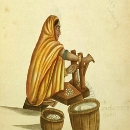
cotton spinning
Agricultural communities became widespread in Kashmir valley around 5000 BC. It was reported that Cotton was cultivated by 5000 – 4000 BC in Kashmir.
As early as 4530 BC and 5440 BC wild Oryza rice appeared in the Belan and Ganges valley regions of northern India. At that time hemp was also domesticated and its applications was in number of things including making narcotics, fibre and oil.
Ancient Indian Agriculture in Indus Valley Civilization
Indus Valley civilization relied on the considerable technological achievements of the pre-Harappan culture, including the plough. The farmers of the Indus Valley grew peas, sesame, and dates. Rice was cultivated in the Indus Valley Civilization.
Indus civilization people practiced rainfall harvesting. At a recently discovered Indus civilization site in western India, archaeologists discovered a series of massive reservoirs, hewn from solid rock and designed to collect rainfall, that would have been capable of meeting the city's needs during the dry season.
The Indus cotton industry was well developed and some methods used in cotton spinning and fabrication.
Agricultural activity during the second millennium BC included rice cultivation in the Kashmir and Harrappan regions are noticed. Mixed farming was the basis of the Indus valley economy.
Several wild cereals, including rice, grew in the Vindhyan Hills, and rice cultivation, at sites such as Chopani-Mando and Mahagara, was underway as early as 7000 BC. Chopani-Mando and Mahagara are located on the upper reaches of the Ganges drainage system.
Irrigation was developed in the Indus Valley Civilization by around 4500 BC. The size and prosperity of the Indus civilization grew as a result of this innovation. It eventually led to more planned settlements making use of drainage and sewers.
Sophisticated irrigation and water storage systems were developed by the Indus Valley Civilization, including artificial reservoirs at Girnar dated to 3000 BC, and an early canal irrigation system in 2600 BC.
Archaeological evidence of an animal-drawn plough dates back to 2500 BC. Some animalsthought to be vital for survival were worshiped. Trees were also domesticated and worshiped. Pipal and Banyan tree was venerated. Others tress that had their medicinal uses found mention in the holistic medical system Ayurveda.
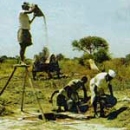
crop protection
Ancient Indian Agriculture in Vedic period
There are repeated references to iron in the later Vedic texts (BC. 1000–500 BC). Cultivation of a wide range of cereals, vegetables, and fruits is described in the text. Meat and milk products were part of the diet; animal husbandry was important. The soil was ploughed several times. The importance of seeds was emphasised and a certain sequence of cropping were recommended. Cow dung provided the manure and irrigation was practiced was during this time.
Ancient Indian Agriculture in Mauryan Empire
The Mauryan Empire (322–185 BCE) categorized soils and made meteorological observations for the agricultural use. Other Mauryan facilitation included construction and maintenance of dams and provision of horse-drawn chariots—that was quicker than traditional bullock carts.
The Greek diplomat Megasthenes (300 BC) in his book Indikaprovides an eyewitness account of Indian agriculture at that time.
He writers, “India has many huge mountains which abound in fruit-trees of every kind, and many vast plains of great fertility. The greater part of the soil is under irrigation, and consequently bears two crops in the course of the year.In addition to cereals, there grows millet, anddifferent sorts of pulse and rice throughout India. Since there are two monsoons in the course of each year the inhabitants gather in two harvests annually. “
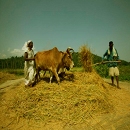
South Indian agriculture
Ancient South Indian Agriculture
The agriculture scene of South India was equally bright in Ancient India. The Tamil people cultivated a wide range of crops such as rice, sugarcane, millets, black pepper, various grains, coconuts, beans, cotton, plantain, tamarind and sandalwood, Jackfruit, coconut, palm, areca and plantain trees etc.
Systematic ploughing, manuring, weeding, irrigation and crop protection was practiced for sustained agriculture in South India.
Water storage systems were designed during this period. Kallanai (1st-2nd century AD), a dam built on river Kaveri, is considered the as one of the oldest water-regulation structures in the world that is still in use.
Agriculture Trade in Ancient India
Foreign crops were introduced to India and Indian products soon reached the world via existing trading networks. Spice trade involving spices such as cinnamon and black peppergained momentum and India started shippingthem to the Mediterranean.
The detailed archaeological record and the Periplus of the ErythraeanSea show that India’s trade with Roman Empire flourished. During the early centuries of the Common Era, Chinese sericulture attracted Indian sailors.
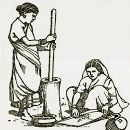
The agrarian societyThe earliest reference of candied sugar or crystallized sugar comes from the time of the Guptas (320-550 AD). Soon the traveling Buddhist monkstransmitted the process of making sugar to China. Chinese documents confirm at least two missions to India, initiated in 647 AD, for obtaining technology for sugar-refining.
Indian spice exports find mention in the works of IbnKhurdadhbeh (850), al-Ghafiqi (1150), Ishak bin Imaran (907) and Al Kalkashandi (fourteenth century).
Ancient Indian Agriculture in Chola Period
The agrarian society in South India during the Chola Empire (875-1279) reveals that collective holding of land slowly gave way to individual plots, each with their own irrigation system during Chola rule.
The Cholas also had bureaucrats which oversaw the distribution of water, particularly the distribution of water by tank-and-channel networks to the drier areas. The growth of individual disposition of farming may have led to a decrease in areas of dry cultivation.
TOOLS AND TECHNOLOGY:-
Following the green revolution in the 1960s, farmers in South Asia pursued both intensive and extensive agriculture. Public, Private, and Government encourage Farmers to use better machinery for all farm tasks. Often village artisans built Agricultural machinery in rural south Asia, including India. These artisans include carpenters and blacksmiths, small-scale industries, and organized medium companies. Village artisans make most of the traditional tools of agriculture and bullock-drawn implements.

The organized industry has focused on high-tech machineries such as tractors, engines, rice mills, oil mills, and flour mills. Nowadays, so many modern and increasingly high-tech farming methods are available, each with its own set of pros and cons.
Unlike modern methods, traditional tools of agriculture have withstood the test of time. So, here we present you with the list of traditional tools of agriculture that our ancestors have used.
List Of Traditional Agriculture Tools
Traditional Tools Of Agriculture -Ploughing
1. Plough (Lungal)

- It is one of the most popular and important traditional tools of agriculture.
- Typically, small farmers and farm owners with scattered properties cannot employ tractors; hence they choose ox-ploughs. The plough’s essential components are a shoe, a body, a handle, and a beam.
- You can use this traditional agriculture tool to till fields before planting with a pair of oxen.
- It features a single bottom desi plough and a ploughing depth of 15 cm on average.
- Moreover, his traditional agriculture tool contains a facility for adjusting the hitching point, which you may alter based on oxen height and working depth.
- The price of this Traditional agriculture tool ranges from INR 800-1500.
2. Spader (Plough)
- This traditional agriculture tool is comparable to Lungal, but it does not handle it. It is usually used for forming furrows and covering the soil to make bunds by hand pulling.
- The traditional agriculture tool costs approximately INR 600.
- It is one of the commonly used traditional tools of agriculture that you could see farmers in modern times too.
Traditional Tools Of Agriculture -Operations
1. Khurpa (Khurpi)
Farmers use it to break up the soil. It is one of the popular and handy traditional tools of agriculture for soil. It is a hand-operated tool that farmers use to eradicate weeds. Farmers use The narrow edge khurpi to raise the root media of weeds, carrots, and radishes.
- It is one of the cheapest traditional tools of agriculture.
- It has a total length of 0.3 m, a working length of 0.16 m, a working edge of 0.025 m, and a cost of INR 20.
- Farmers in villages who cannot afford weeders use this traditional agriculture tool to eradicate weeds.
2. Weeder (Aruguvetti)
Farmers use this traditional agriculture tool for removing deep-rooted weeds along with their rhizomes. This weeder easily removed weeds like Bermuda and other grasses with the help of this weeder.
- The tool made up of iron has a handle (length 50 cm and 8 cm diameter) and working area, i.e., the comb-like structure has a length of 25 cm and 30 cm diameter).
- The farm laborers first pierced the soil with the help of this weeder and lifted the soil upwards. Another farmer should remove the uprooted weeds from the soil using other farm implements called mammutty (spade).

Photo By ROCKETMANN TEAM From Pexels
- Farmers could cover about 2 acres/day using this traditional agriculture tool.
- It is one of the traditional tools of agriculture with many other advantages like loosening the soil earthing up are achieved during weeding operation.
- It is one of the traditional tools of agriculture that mostly male laborers operate. The average life is 10 yrs and costs Rs120/unit.
- It is traditional form of modern rake.
Traditional Agriculture Tool- Harvesting Tools
1. Sickle (Karukkarival)
- Farmers use this traditional agriculture tool in harvesting most crops like cereals, pulses, and millets. The sickle has a design of ‘C’ shaped/curved to ease the harvesting operation.
- It is one of the traditional tools of agriculture preferred more than other tools and implements. With the help of a sickle, the ear heads, branches, or even you could harvest the whole plant.

Photo By Srihari Surya Vamsi Batchala From Pexels
- Additionally, The working area has iron, and the construction of the handle is made of wood of Acacia sp. The working area has 20 cm length and 3 cm width.
- The handle is 15 cm in height and 5 cm in width.
- This traditional agriculture tool; its average life is 5 yrs and costs Rs 25/unit.
2. Knife (Kambar Kathi)
It is very small and handy, made up of iron. Farmers use it in harvesting the pulses crop like black gram (Vigna mungo), horse gram (Macrotyloma uniflorum), Bengal gram (Cicer arietinum).

- Likewise, It is also useful in harvesting ear heads of millets like sorghum (Sorghum bicolor), cumbu (Pennisetum glacum), ragi (Eleusine coracana), etc.
- It is the most popular among traditional tools of agriculture in Southern India. The working area of this traditional agriculture tool has a curved surface of 8 cm, and the handle has a length of 5 cm.
- Moreover, Both male and female workers could operate this traditional agriculture tool. Its average life is 5 yrs and costs Rs 10/ unit.
Traditional Tools Of Agriculture- Post-Harvest
1. Grain Separator (Kodun Kol)
Before winnowing horse gram(Macrotyloma uniflorum), farmers use this traditional agriculture tool . After drying, farmers thresh the plants with the help of tractors.
- After threshing, farmers, with the help of a grain separator, shake the plant materials forcibly so that the threshed materials and the grains are separated. Then the farmers collected the grains from the ground and cleaned them manually.
- The traditional agriculture tool consists of a long handle of wood attached with a single or double iron rod. The handle has a length of 200 cm and the iron rod of length 10 cm. It helps separate the threshed materials and grains, making the winnowing operation easier.
- Also, farmers can handle this traditional agriculture tool by standing straight without bending, thus reducing drudgery.
- It is one of the traditional tools of agriculture operated by both male and female laborers. Its average life is 20 yrs and costs INR 30/unit.
2. Wooden Thresher (Thattuppalagai)
Farmers use this traditional agriculture tool for threshing operation in crops like black gram (Vigna mungo), green gram (Vigna radiata), horse gram (Macrotyloma uniflorum), etc.

- The tool made up of wood has a handle of length 28 cm and a flat rectangular working board of 20 cm length and 12 cm breadth.
- Along with that, A wooden thresher eases the manual threshing operation. It is one of the traditional tools of agriculture in which Both male and female laborers operate.
- The average life is one year and costs INR 15/unit.
3. Stone Roller (Uruttu Kal)
Farmers use the stone roller in the threshing of pulse crops like green gram (Vigna radiata), horse gram (Macrotyloma uniflorum), black gram (Vigna mungo), cereals and millets, etc.

- It is one of the popular traditional tools of agriculture in the southern Indian state, Tamil Nadu. It is a circular roller of length 95 cm and a diameter of 30 cm.
- Threshing with the stone roller is quicker and more effective than manual threshing. Usually, male labor operates this traditional agriculture tool, and the average life is 20 yrs and costs Rs100/unit.
4. Bamboo Winnower (Muram)

Photo By Michael Burrows From Pexels
Farmers use this traditional agriculture tool in cleaning and winnowing pulse grains. They are highly preferred for their shape and utility of various crops, such as pulses, cereals, millets, and oilseeds.
- It is one of the peculiar traditional tools of agriculture.
- The artist constructs it with bamboo sticks. There is a coating of cow dung paste to fill up the holes/gaps.
- It is ‘U’ shaped and has a length, breadth, and depth of 35 cm × 25 cm × 3 cm.
- Household women generally operate these traditional tools of agriculture. Its average life is 2 yrs and costs Rs 20/unit.
5. Stone Grinder (Chekku)
The traditional agriculture tool is cheaper and more effective in grinding, preferable in rural areas. It is one of the traditional tools of agriculture that farmers use for milling all kinds of cereals.

- Moreover, Farmers also use it in crushing leaves during leaf formulations. It is very popular for grinding rice (Oryza sativa), cotton seeds (Gossypium sp), etc.; the construction of tools is made from stone.
- Additionally, It has a height of 140 cm, and the diameter of the working area is 15 cm.
- Usually, household women operate this tool, and its average life is 10 yrs and costs Rs.100/unit.
Conclusion
Henceforth no matter how modernization has made a huge impact on agriculture. Whereas traditional tools of agriculture still hold a special place. Indigenous tools are still somehow successful because they are economical, feasible, and sustainable. It can spread quickly and easily from one region to another.
Even these tools are common; generally, people don’t recommend them. Since they lower the efficiency and increase the tiredness of the operator. Therefore, By using modern wisdom, we need to standardize traditional tools of agriculture, keeping in mind the economy of the rural poor. Consequently, Proper designing following the farmer’s requirements surely soon popularizes these traditional agriculture tools and implements.

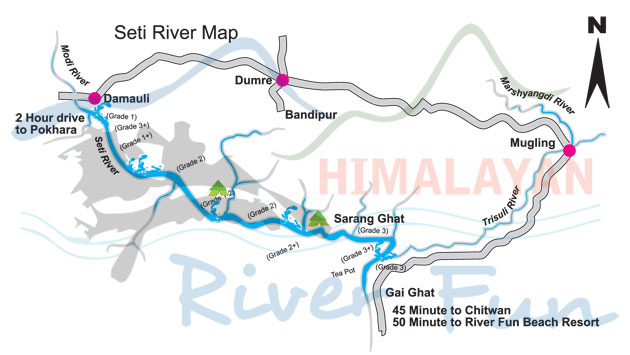
Comments
Post a Comment